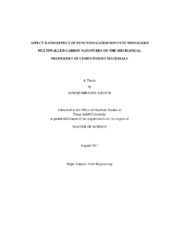| dc.description.abstract | The focus of this research was to investigate the use of functionalized/non-functionalized multi walled carbon nanotubes (MWCNTs) as reinforcements for the Portland cement paste. The unique geometrical characteristics of the carbon nanotubes (CNTs), as well as its unique mechanical properties such as high strength, ductility and stiffness, were the vital motivation for this study. In this research, we combined this unique material (CNTs) with concrete which is the most used man-made material. When compared to other composite materials, a limited amount of research has been conducted on the CNTs/cement composites.
In order to investigate how the aspect ratio of functionalized/non-functionalized MWCNTs affects the mechanical properties of cementitious composites, ten different mixes of the MWCNTs/cement composites were prepared and tested. The different batches had a fixed water/cement ratio of 0.4, and variations of MWCNTs length, concentration and surface treatment. The cement nanocomposites were cast in small-scale specimens (beams) for the three-point flexural testing. Four major mechanical properties were evaluated at ages of 7, 14, and 28 days from the casting day: the maximum flexural strength, ultimate strain capacity (ductility), modulus of elasticity, and modulus of toughness. The results for the different nanocomposite batches were compared with the plain cement (reference) batch.
The mechanical testing results showed that at 28 days almost all of the MWCNTs composites increased the flexural strength of the cement nanocomposites. At 28 days, the long MWCNTs increased the flexural strength more than the short MWCNTs. In general, the ultimate strain (ductility) of the short MWCNTs nanocomposites was higher than the ultimate strain of the long MWCNTs nanocomposites. The flexural strength of short 0.2 percent MWNT and long 0.04 percent MWNT (OH) increased by 269 percent and 83 percent, respectively, compared to the plain cement sample at 28 days. The highest ductility at 28 days for the short 0.1 percent MWNT and the short 0.2 percent MWNT was 86 percent and 81 percent, respectively.
Clear evidence was obtained from the SEM images for micro-crack bridging; many of the MWCNTs were stretching across the micro-cracks.
In conclusion, CNTs as nano reinforcements, can effectively improve certain mechanical properties of the cement paste composites. | en |


